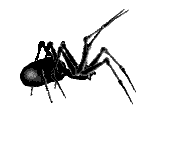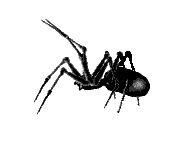





 Listings
and Legislation
Listings
and Legislation
![]() 2000
IUCN Red List of Threatened Animals
2000
IUCN Red List of Threatened Animals
The 2000 IUCN Red List of Threatened Animals provides information on rare and threatened species around the world. While this list does not provide direct legal protection, it is often used to identify conservation targets. Some arachnids have been listed including 15 spiders. No changes in the spider fauna occured since the 1996 Red List.
Results of a Red List taxonomic query for Order Araneae (10/4/00):
| Family | Common Name | Scientific Name | Category/Criteria** | Distribution |
| Ctenizidae | Torreya trap-door spider | Cyclocosmia torreya | Data deficient/- | USA |
| Gnaphosidae | Key gnaphosid spider | Cesonia irvingi | Data deficient/- | Bahamas, USA |
| Gradungulidae | Nelson cave spider | Spelungula cavernicola | Data Deficient/- | New Zealand |
| Hexathelidae | <unavailable> | Macrothele cretica | Data Deficient/- | Greece |
| Leptonetidae | Tooth Cave Spider | Neoleptoneta myopica | Data deficient/- | USA |
| Linyphiidae | Kocevje subterranean spider | Troglohyphantes gracilis | Vulnerable/D2 | Slovenia |
| Linyphiidae | Kocevje subterranean spider | Troglohyphantes similis | Vulnerable/D2 | Slovenia |
| Linyphiidae | Kocevje subterranean spider | Troglohyphantes spinipes | Vulnerable/D2 | Slovenia |
| Lycosidae | Kauai cave wolf spider | Adelocosa anops | Endangered/B1+2c | USA |
| Lycosidae | Rosemary wolf spider | Lycosa ericeticola | Data Deficient/- | USA |
| Lycosidae | Glacier Bay wolf spider | Pardosa diuturna | Vulnerable/D2 | USA |
| Lycosidae | Lake Placid funnel wolf spider | Sosippus placidus | Vulnerable/D2 | USA |
| Pisauridae | Great raft spider | Dolomedes plantarius | Vulnerable/A1ace+2ce | Austria, Belarus, Belgium, Denmark, France, Georgia, Germany, Hungary, Italy, Latvia, Lithuania, Netherlands, Poland, Romania, Russia, Slovakia, Sweden |
| Tetragnathidae | Dolloff cave spider | Meta dolloff | Vulnerable/D2 | USA |
| Theraphosidae | Red-kneed tarantula | Euathlus smithi | Lower Risk: Near Threatened/- | Mexico |
**For details on the the IUCN threat category notation, click here.
![]() Convention
on International Trade in Endangered Species (CITES)
Convention
on International Trade in Endangered Species (CITES)
In 1995, all spider species of the genus Brachypelma (which includes
the Mexican red-kneed tarantula) were listed on Appendix II of CITES.
This designation is for species that are not currently threatened by extinction
but have the possibility of becoming threatened if trade is not regulated.
This includes the following Brachypelma species (from a query of
the CITES species database on Order Araneae):
| albopilosum (Curlyhair)
angustum (Costa rica red) auratum (Mexican orange beauty) aureoceps (Florida golden chestnut) baumgarteni (Mexican fireleg) boehmei(Mexican rustleg) emilia (Mexican redleg) |
epicureanum (Yucatan rust rump)
fossorium (Costa Rican rustbrown) klaasi (Mexican pink) pallidum (Mexican rose) sabulosum (Guatemalan redrump) smithi (Mexican redknee) vagans (Mexican redrump) |
While these species are still available in the pet trade through captive breeding and regulated trade, restrictions on their import and export across national borders is in place.
It is important to note that additional research on the status of natural populations of these species is needed in order to characterize the actual threat, if any, posed by collection pressures. Little is known about the geographic distribution of many of these species. It is possible that they could be negatively impacted by overcollection due to their long life spans, population structures, and sensitivity to environmental stochasticity (Wolff 1995). For another perspective on this topic from tarantula enthusiasts, visit the American Tarantula Society site where some discussion of this topic has ensued.
![]() Wildlife
& Countryside Act 1981 (UK)
Wildlife
& Countryside Act 1981 (UK)
Two species are protected from harm, collection, or trade: Dolomedes plantarius and Eresus niger.
Four species are protected under this law: Argiope bruennichi, Atypus affinis, Dolomedes fimbriatus, and Argyroneta aquatica.
![]() Transvaal
Provincial Nature Conservation Ordinance of 1983 (South Africa)
Transvaal
Provincial Nature Conservation Ordinance of 1983 (South Africa)
Three genera of the family Theraphosidae, including Ceratogyrus, Harpactira and Pterinochilus were added to Schedule Seven of the Transvaal Provincial Nature Conservation Ordinance of 1983 as Protected Invertebrate Animals.
![]() Wildlife
Amendment Act, 1980 (New Zealand)
Wildlife
Amendment Act, 1980 (New Zealand)
One species (Spelunga cavernicola) is listed in the Seventh Schedule and afforded some measure of protection.